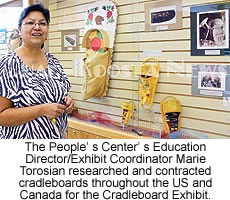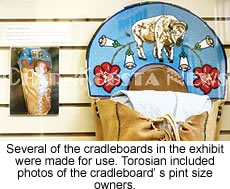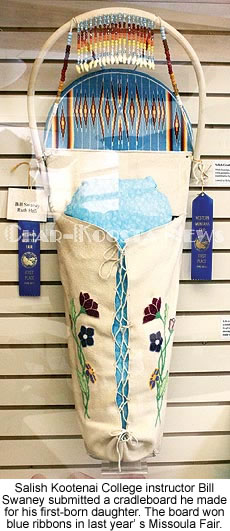 |
Canku Ota
|
 |
|
(Many Paths)
|
||
|
An Online Newsletter
Celebrating Native America
|
||
|
March 2013 - Volume
11 Number 3
|
||
|
|
||
|
Cradleboard Exhibit
Showcases Many Styles and Cultures of Infant Carriers
|
||
|
by Alyssa Nenemay -
Char-Koosta News
|
||
|
credits: photos by Alyssa
Nenemay
|
|
Cradleboards are traditional infant carriers that are constructed of a sturdy wooden frame. Infants are securely laced and swaddled within the frame in a buckskin or cloth bag. Torosian said that moss was used to line the bag and absorb bodily fluids-much like a diaper. Some designs even allowed for cradleboards to be suspended or
propped against surfaces like trees or large rocks. This assured
the child would remain in eye view and freed up their caretaker’s
time for work without disrupting the bonding process. Aside from its functional uses, cradleboards had physical and mental benefits. Torosian said the swaddling bag provided security, much like a mother’s womb, but allowed for observation and stimulation of the baby’s surroundings. Some designs even provided spinal support or protection from the elements. As the child grew, the cradleboard taught restraint and patience.
“Cradleboards were used by tribes all over and throughout my research it was interesting to see all the similarities,” said Torosian. “Tribes had different designs because of their climate, but we all used similar fibers to make the cradleboards.” Torosian’s inspiration for the display came from an overwhelming interest of callers asking the center to host classes on how to make them. “A while back, cradleboards were hung on the wall for decoration but now you’re seeing where people have decided to take it off the wall and use it. It’s not a wall display, it’s who we are,” said Torosian. Most of the cradleboards featured in the exhibit were used and include photos of its pint size owners. “I really wanted to include photos of the cradleboards being used because each one has its own story,” said Torosian. One of the stories includes a cradleboard Bill Swaney made for his first-born daughter. Aside from carrying his daughter, the board and its detailed beadwork won blue ribbons in last years’ Missoula Fair.
|
||
|
|
||
|
|
||
| Canku Ota is a free Newsletter celebrating Native America, its traditions and accomplishments . We do not provide subscriber or visitor names to anyone. Some articles presented in Canku Ota may contain copyright material. We have received appropriate permissions for republishing any articles. Material appearing here is distributed without profit or monetary gain to those who have expressed an interest. This is in accordance with Title 17 U.S.C. Section 107. | ||
|
Canku Ota is a copyright ©
2000 - 2013 of Vicki Williams Barry and Paul Barry.
|
||
 |
 |
|
|
The "Canku
Ota - A Newsletter Celebrating Native America" web site and
its design is the
|
||
|
Copyright ©
1999 - 2013 of Paul C. Barry.
|
||
|
All Rights Reserved.
|
||
 PABLO
— The People’s Center’s latest “Cradleboard
Exhibit” recounts cultural uses of the carrier, from its historical
origin to its role in modern life. “I think it really highlights
the craftsmanship our people still have today,” said the exhibit’s
coordinator Marie Torosian.
PABLO
— The People’s Center’s latest “Cradleboard
Exhibit” recounts cultural uses of the carrier, from its historical
origin to its role in modern life. “I think it really highlights
the craftsmanship our people still have today,” said the exhibit’s
coordinator Marie Torosian. Torosian
has been researching and contracting cradleboards from all over
the US and Canada for the 23 piece display. While most of the items
were submitted locally, visitors have an opportunity to see cradleboard
models from the Apache and Hopi tribes as well.
Torosian
has been researching and contracting cradleboards from all over
the US and Canada for the 23 piece display. While most of the items
were submitted locally, visitors have an opportunity to see cradleboard
models from the Apache and Hopi tribes as well.
